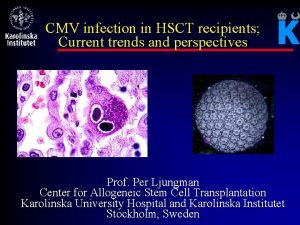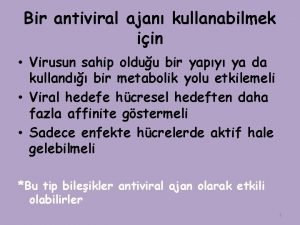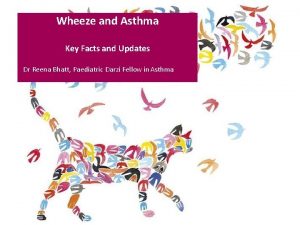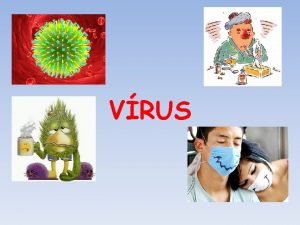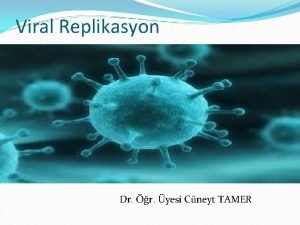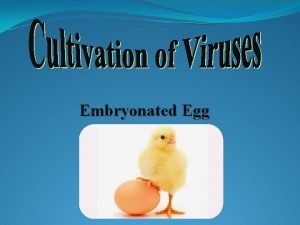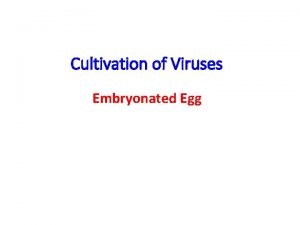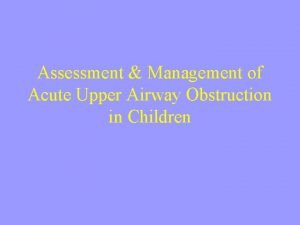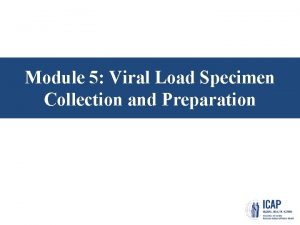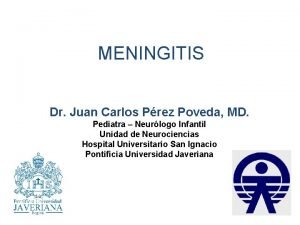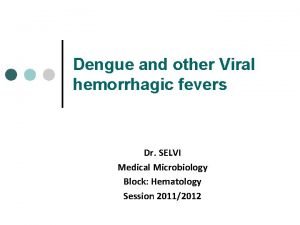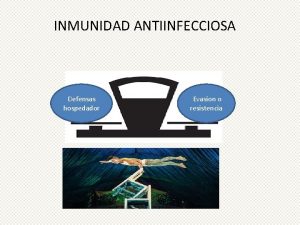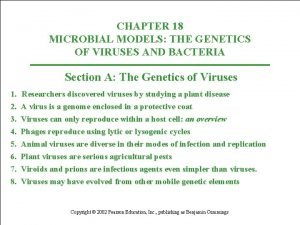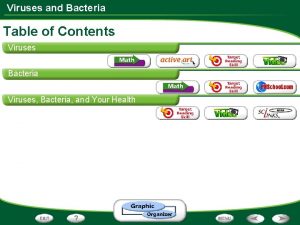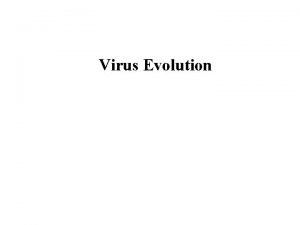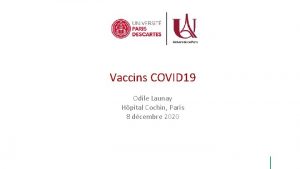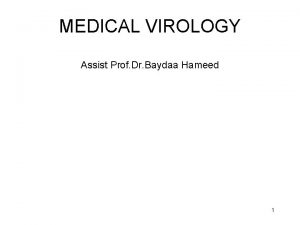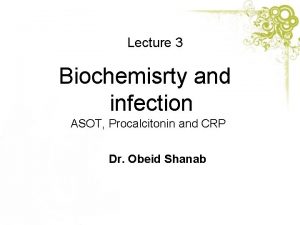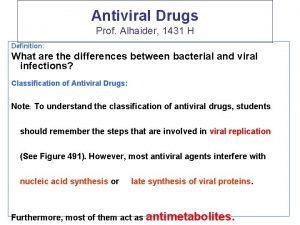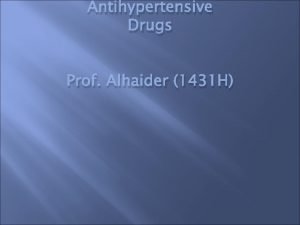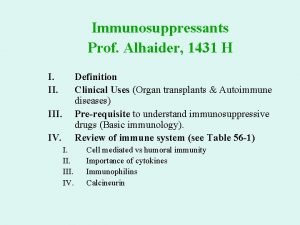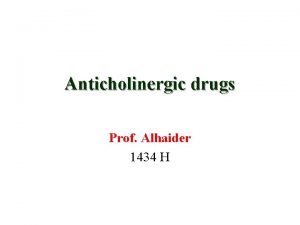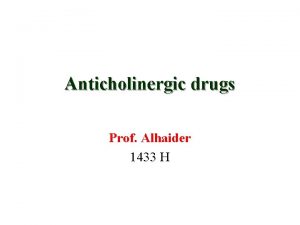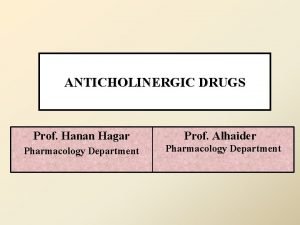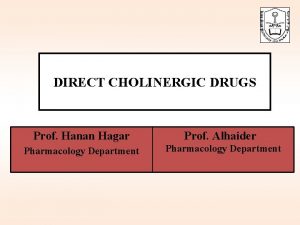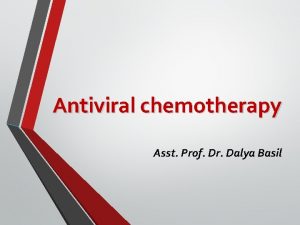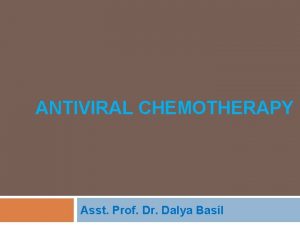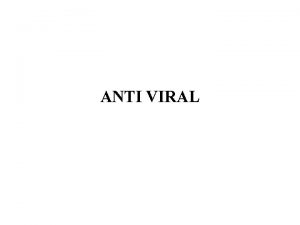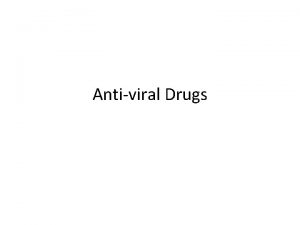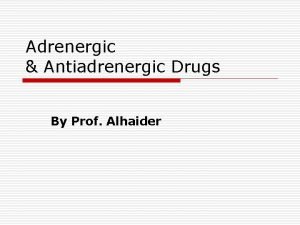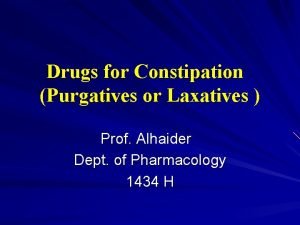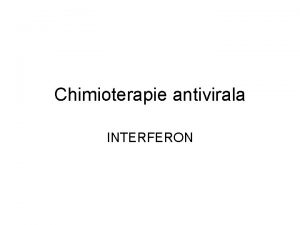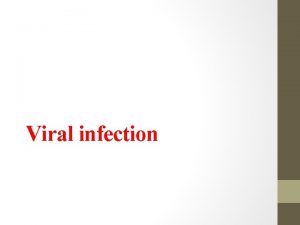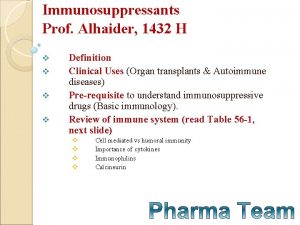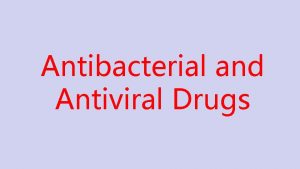Antiviral Drugs Prof Alhaider 1431 H Definition Viral






















- Slides: 22

Antiviral Drugs Prof. Alhaider, 1431 H Definition: Viral infections depend on the host cells. Therefore, antiviral drugs must block viral entry or exit or the activitiy of the virus inside the cell Classification of Antiviral Drugs: Note: To understand the classification of antiviral drugs, students should remember the steps that are involved in viral replication (See next slide). However, most antiviral agents interfere with nucleic acid synthesis or late synthesis of viral proteins. Furthermore, most of them act as antimetabolites.

Steps of viral replication 1 3 2 4 5 7 8 6

Classification of Antiviral Drugs • Best Classification Based on 1) Type of Viral Infections (Organisms) or 2) its site: Agents to Treat Herpes Simplex virus (HSV) and Varicella Zoster Virus (VZV) infections. II. Agents To Treat Cytomegalovirus infection (CMV) III. Drugs Used for Rx of AIDS (Antiretroviral Agents) IV. Antihepatitis Agents V. Antiviral Used for Respiratory Tract Infections • I. • •

Table 2: Types of Antiviral drugs 1 2 3 4

1) Agents to Treat Herpes Simplex virus (HSV) and Varicella Zoster Virus (VZV) infections. • Examples: Acyclovir (prototype); Valcyclovir; Famiciclovir; Trifluridine (Topical) Mechanism of action Step 1: • three phosphorylation steps are required. • The 1 st one needs viral thymidine kinase. • The rest need host thymidine kinase. Step 2: • The result of step 1 is (acyclo-GTP) Acyclo-GTP Incorporation into Viral DNA Chain termination Competitive inhibition of viral DNA polymerase Inhibition of viral DNA synthesis

These drugs are guanosine analogs without sugar moiety, so they block DNA elongation of virus They can’t effect human cells because they need viral enzymes, so they are more


Resistance: • Can be developed due to deficient or alteration of thymidine kinase and or alteration DNA polymerases. • Cross resistance: to valcyclovir, famiciclovir and gancyclovir • but no cross resistance for cidofovir (because it doesn’t need viral thymidine kinase for action) (see anti-CMV)

PK of Acyclovir : –is available as topical, I. V. and oral (bioavailability: 15 -20% low) (not affected by food), –Short t 1 l 2 3 hr thus given 4 -5 times daily and eliminated mainly by kidney (t 1 l 2 prolonged in renal impairment) may reach 20 hr (the main disadvantage) , –Distribute in ALL parts of the body including CNS (e. g: encephalitis). Concentration in the CNS = ½ conc. In serum Clinical Uses (see Table 49 -1) HSV, Varicella-zoster VZV; Epstein-Barr virus mediated infection; HSV encephalitis; Genital herpes infection. –What is Valacyclovir? It’s the L-valyl ester of acyclovoir. It given IV if the infection is so sever How valcyclovir differs from acyclovir? – – High oral bioavailability; long duration (almost five times the plasma concentration) Can replace I. V. acyclovir Effective even for CMV (but it’s not the drug of choice) Valcyclovir is a prodrug of acycolvir


Side Effects of Acyclovir (Generally speaking, acyclovir considers to be safe drug (remember slide #6) however, it may produce: 1. Transient Renal dysfunction at high dose or at IV (Crystalline Nephropathy). It’s uncommon with adequate hydration and avoid rapid infusion rates 2. GIT disturbances Side Effects of Aalacyclovir Thrombotic thrombocytopenic purpura (TTP) and hemolytic-uremic syndrome in pts with AIDS


• II. Agents To Treat Cytomegalovirus infection (CMV) • Ganciclovir: Analog of acyclovir • Why Acyclovir is not active against CMV? Because the affinity of CMV thymidine kinase to acyclovir is very low • MOA: Similar to acyclovir • PK: – Administered I. V. , orally (poor bioavailability), intraocular implant. – T 1/2 = 4 hr (short) – Kidney clearance Valganciclovir: • L-valyl ester of ganciclovir. • Oral replacement for IV ganciclovir

Clinical Uses of Ganciclovir: IV: (commonly used formulation) - to delay the progression of CMV retinitis in patients with AIDS, 2 weeks followed by oral form) - for CMV colitis, esophagitis and pneumonitis. - to prevent CMV before trasplantation. Oral: (Used for prophylaxis) - CMV prophylaxis in transplant patients - prevention of end organ CMV disease in AIDS patients. - as maintenance therapy for CMV retinitis. Intraocularly (implant): Rx CMV retinitis.

Adverse Effects of Ganciclovir: - Myelosuppression (neutropenia 20 -30%) and increases if given with Zidovudine, azathioprime, or mycophenolate mofetil) - Vitreous hemorrhage and retinal detachment with intraocular implant. - Mitogenicity in mammalian cells and carcinogenic in animals at high dose

• Cidofovir: – Differs from acyclovir in its long t 1/2 26 hr with active metabolite. and MOA. – MOA: phosophorylation does not depend on viral enzyme, and works as inhibitor and alternative substrate for viral DNA polymerase. – Activity: CMV; HSV; VZV – Used for CMV retinitis, colitis, and esophagitis. and for Acyclovir-resistant PK: produce active metabolite, thus it has long t 1/2, eliminated in the kidney, Probenicid prolonged its action. but with poor CNS penetration. Why acycoliver is better than Cidofovir for encephalitis? Side effects: Dose-dependent nephrotoxicity (53%) and uveitis and decrease IOP (intra ocular pressure)

• Note: Normally, DNA RNA however, • Reverse transcriptase = RNA-directed DNA polymerase (DNA polymerase that transcribes single- stranded RNA into double-stranded DNA.

• III. Drugs Used for Rx of AIDS (Antiretroviral Agents) – AIDS are caused by HIV, and zidovudine was the first drug used (1987). – To understand drugs used for AIDS, the life cycle of HIV should be utilized for drugs combination (See next slide) – Drug combination or the so-called Highly Active Antiretriviral Therapy (HAART) (Figure 38 -17) as well as adherence to the regimen, both are very essential. HIV is always in mutation through it cycle, so combination & adherence is recommended. Classification of Anti AIDS (Based on life cycle) Table 2 and Figure 38 -17): 1) Nucleotide Reverse Transcriptase Inhibitors (NRTIS) 2) Non Nucleotide Reverse Transcriptase Inhibitors (NNRTIS) 3) Protease Inhibitors e. g. Saquinavir; Ritonavir; Indinavir 4) Viral Fusion Inhibitor e. g. Enfuvirtide



• Objectives of HIV Treatment: – Suppression of viral replication (decrease the viral load). – Restoration of a degree of immunocompetency to the host. – Decrease incidence of opportunistic infections. – prolonged survival

 Second antiviral pill
Second antiviral pill Idoksüridin
Idoksüridin Aerochamber definition
Aerochamber definition Vrus
Vrus Section 24-1 viral structure and replication
Section 24-1 viral structure and replication Viral replikasyon basamakları
Viral replikasyon basamakları Egg inoculation diagram
Egg inoculation diagram Viral inoculation in embryonated egg
Viral inoculation in embryonated egg Viral inoculation in embryonated egg
Viral inoculation in embryonated egg Spasmodic croup
Spasmodic croup Dea anggraini viral
Dea anggraini viral Exocitose
Exocitose Viral load sample collection
Viral load sample collection Que causa la meningitis
Que causa la meningitis Causes of viral hemorrhagic fever
Causes of viral hemorrhagic fever Ciclo viral
Ciclo viral Viral infection
Viral infection Viral
Viral Viral recombination
Viral recombination Vaccins à vecteur viral
Vaccins à vecteur viral Viral receptors
Viral receptors Streptococcus
Streptococcus Rhinopneumonitis definition
Rhinopneumonitis definition
